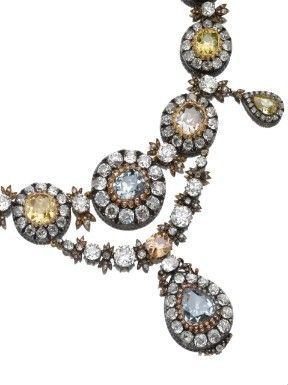A Superb Suite of Imperial Jewels, Mid 19th Century
Towards the end of 1710, under the influence of Charles XII of Sweden, the Ottoman Sultan declared war on Russia. The foremost event of this conflict was the Pruth River Campaign, which lasted several days in July 1711. Russian troops under the command of Peter the Great attempted to invade Moldavia in Eastern Europe. Ill prepared, the Russian forces soon found themselves surrounded by the Turkish army on the Pruth River. Without enough ammunition, food or water supplies, what was anticipated to be but a few days siege turned into an insurmountable battle for the Russians. Long negotiations between Peter the Great and the Grand Vizier Baltaa Mehmet-Pasha, commander in chief of the Turkish forces, proved unfruitful and the Russian's fate looked grim.
Catherine I of Russia, second wife of Peter the Great, is said to have saved not only her husband but also the empire, as related by Voltaire, when she accompanied her husband to the River Pruth. In the hours while Peter was resting before what was to be the final battle, Catherine reconvened the War Council to reassess the great danger of their planned military breakthrough. She proceeded to wake Peter begging him to pen one final letter to the Turkish Vizier in order to peacefully resolve the conflict. Meanwhile, in secret, Catherine gathered all of her jewels, both family heirlooms and gifts from her husband, sending them alongside this letter in hopes of easing negotiations. The gift of the jewels was duly accepted and a peace treaty was drawn. Amongst his losses, Peter the Great also was forced to return control of the Black Sea port of Azov, near the Don River. In return the Sultan Ahmed III expelled the disappointed Swedish Charles XII from Ottoman territory.
The jewels from Catherine are believed to have then passed into the Ottoman Treasures and were, by tradition, used by the Sultan Abdül Hamid II (1842-1918) for the present necklace which he presented to the wife of the Khedive Teufik of Egypt, possibly on the occasion of the birth of their son and heir Abbas II Hilmi Paa (1874-1944). Born HH Princess Emine-Nacibe Hanimefendi, the "Valida Sultana" or "Valide Pasha" became the most powerful woman of the region and political mentor to her son Abbas. The first consort to be styled Khediva Effendimiz, she was also known as "Umm al-Mu'hsinin" in recognition of her many charitable works. While still attending college in Vienna, her son, HH Abbas II Hilmi Paa, assumed the throne with the help of his mother. The Khedive of Egypt and Sudan, Abbas' reign was marked by tensions with the United Kingdom whose armies had occupied Egypt since 1882. With the Ottoman Empire's engagement in World War I, the British declared Egypt an independent Sultanate under a protectorate on the 18th of December 1914 and deposed of Abbas. Barred from entering British territory, he retired to Switzerland where he died on the 19th of December 1944, in Geneva. His son, the Prince Muhammad Abdul Moneim (1899-1979), was husband to the consignor of the jewels to the Christie's sale of 1963.
This parure of jewels is probably the most important suite of antique coloured diamond jewels to appear at auction in the last 50 years. It is difficult to overestimate its rarity.
Sotheby's Magnificent Jewels. Geneva | 15 Nov 2011 - www.sothebys.com

/https%3A%2F%2Fprofilepics.canalblog.com%2Fprofilepics%2F1%2F0%2F100183.jpg)
/https%3A%2F%2Fstorage.canalblog.com%2F03%2F02%2F119589%2F96711876_o.jpg)
/https%3A%2F%2Fstorage.canalblog.com%2F11%2F31%2F119589%2F94773502_o.jpg)
/https%3A%2F%2Fstorage.canalblog.com%2F20%2F83%2F119589%2F94772815_o.jpg)
/https%3A%2F%2Fstorage.canalblog.com%2F26%2F72%2F119589%2F75604929_o.jpg)
/https%3A%2F%2Fstorage.canalblog.com%2F59%2F60%2F119589%2F26458628_o.jpg)




/http%3A%2F%2Fstorage.canalblog.com%2F93%2F84%2F119589%2F110839820_o.jpg)
/http%3A%2F%2Fstorage.canalblog.com%2F17%2F92%2F119589%2F110808396_o.jpg)
/http%3A%2F%2Fstorage.canalblog.com%2F17%2F88%2F119589%2F96153708_o.jpg)
/http%3A%2F%2Fstorage.canalblog.com%2F46%2F71%2F119589%2F96149004_o.jpg)